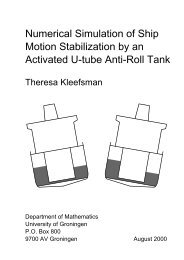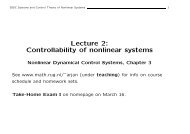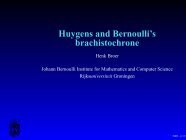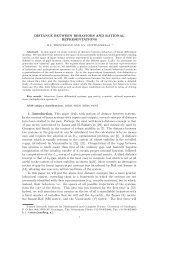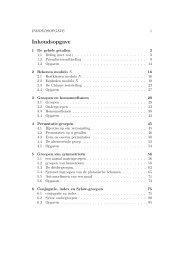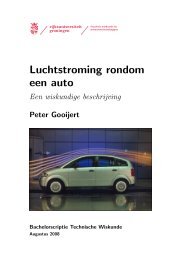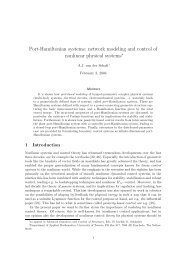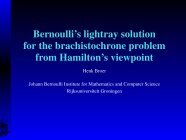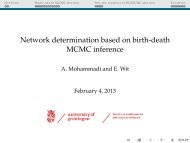Aspects of Scientific Computing - Johann Bernoulli lezingen
Aspects of Scientific Computing - Johann Bernoulli lezingen
Aspects of Scientific Computing - Johann Bernoulli lezingen
You also want an ePaper? Increase the reach of your titles
YUMPU automatically turns print PDFs into web optimized ePapers that Google loves.
<strong>Aspects</strong> <strong>of</strong> <strong>Scientific</strong> <strong>Computing</strong>Gene H. GolubDepartment <strong>of</strong> Computer ScienceStanford UniversityStanford, CA 94305-9025 USAemail: golub@sccm.stanford.eduText <strong>of</strong> the 1995-1996 <strong>Johann</strong> <strong>Bernoulli</strong> Lecture given at theUniversity <strong>of</strong> Groningen on April 8, 1996. The <strong>Johann</strong> <strong>Bernoulli</strong>Foundation for Mathematics, founded in Groningen in 1988 topromote mathematics, organizes each year a <strong>Johann</strong> <strong>Bernoulli</strong>Lecture for which it invites prominent scientists. <strong>Johann</strong><strong>Bernoulli</strong> was Pr<strong>of</strong>essor <strong>of</strong> Mathematics at the University <strong>of</strong>Groningen from 1695-1705.IntroductionIt is a great honor to be here and to speak in this forum. Today has been a wonderful day herein Groningen and I have just been enormously stimulated. Not only is it a great honor to speakin a series named after <strong>Johann</strong> <strong>Bernoulli</strong>, but also because some <strong>of</strong> my predecessors. I want toshow the first thing however how I obtained some information about <strong>Bernoulli</strong>: that was overthe Internet. It is always possible now to get as much information as you like. In fact the amount<strong>of</strong> information that one can obtain is overwhelming, and since I thought to know more about<strong>Bernoulli</strong> I was able to get this directly from some location by just using a search algorithm. Iended up on the following website, which gives an informative description <strong>of</strong> <strong>Johann</strong> <strong>Bernoulli</strong>:http://www.vma.bme.hu/mathhist/Mathematicians/<strong>Bernoulli</strong> <strong>Johann</strong>.html.Former <strong>Bernoulli</strong> lectures were given by Kalman (1992), Zeeman (1993), Halmos (1994) andLenstra (1995). I am very much delighted to speak in a forum where they have spoken and I’dlike to say something about these people.First <strong>of</strong> all let’s note that Kalman and Halmos and Lenstra have all taught and lived in theUnited States. They were not born there, but they came to the United States for extendedperiods. Kalman was born in Hungary, Halmos was also born in Hungary and Lenstra is <strong>of</strong>course a native <strong>of</strong> Holland. That seems very much in the spirit <strong>of</strong> <strong>Johann</strong> <strong>Bernoulli</strong>, because hespent ten years here before he returned to Switzerland. Mathematicians have a long traditionin being para-pathetic. For instance, Euler lived in Russia for many years, Descartes has livedhere in Holland as well as in France, Goldbach has lived everywhere.The US has been very fortunate in this century by the number <strong>of</strong> immigrants that have cometo the US. I myself was born in Chicago, but my parents were immigrants from eastern Europe.Halmos and Kalman, as I say, were both born in Hungary, but they received much <strong>of</strong> theireducation in the US. Kalman got his PhD from Columbia and spent years at several universitiesincluding Stanford (he was at Stanford for several years). Currently he has a position in Floridaand at ETH in Zürich. Halmos grew up in Chicago too; he received his PhD at the University<strong>of</strong> Illinois and he now lives in California. So my life scenario is very similar to his.<strong>Scientific</strong> computing: history and applicationsToday what I am going to talk about is scientific computing, and this is a subject where manyHungarian mathematicians have made a contribution. Three names which really played a verystrong role in scientific computing are Cornelius Lanczos, John von Neumann and Peter Lax.Cornelius Lanczos was born in the nineteenth century in Hungary. In the 30-ies he spent sort1
<strong>of</strong> an oscillatory time between Hungary and the US. During the war years he lived in the USand afterwards he went to Ireland since he was concerned about the political situation in theUS. John von Neumann spent most <strong>of</strong> his adult life in the US. He was an enormously influentialmathematician; I’ll say more about him in just a moment. Of the three Peter Lax would bethe youngest. He is fortunately still alive and his contributions to the numerical solution <strong>of</strong>differential equations cannot be underestimated 1 .Pr<strong>of</strong>ile <strong>of</strong> scientific computingSo what do I mean by scientific computing. As I regard it, scientific computing is a synthesis <strong>of</strong>applied mathematics, numerical analysis and computer science. Each one <strong>of</strong> these areas couldbe defined more precisely. I am not going to say what they are, but we take the broadest view <strong>of</strong>each <strong>of</strong> these topics. For instance, applied mathematics not only covers the traditional area <strong>of</strong>applied mathematics, but also more contemporary topics such as signal processing and controltheory. I think the SIAM journals have displayed a broad interest in applied mathematics inthe US and elsewhere.The other aspect <strong>of</strong> scientific computing that makes it somewhat different from other topicsthat are <strong>of</strong>ten studied is that it is driven by technology and it is driven in two ways. First <strong>of</strong> allmany <strong>of</strong> the new scientific problems that arise come about because <strong>of</strong> technology, that is thereare new problems that are constantly arising leading to different kinds <strong>of</strong> classes <strong>of</strong> mathematicalproblems. And secondly there is the computer revolution, which has now continued through fiftyyears. It is not abided that I am constantly amazed by what is coming next and it seems to beimpossible to foretell. Each new development has allowed us to develop new techniques and getmore insightful information about computation. Numerical experimentation has increasinglybecome more sophisticated and enables us to understand our computational experience to ahigher degree.Von NeumannLet me return to one <strong>of</strong> my heroes, I should say, and that is John von Neumann. Von Neumann(1903-1957) occupied a position at the Institute for Advanced Study and in a sense he is thegreat scientific computor. Here are just a few <strong>of</strong> the contributions that he made in the 54 yearsthat he lived.First <strong>of</strong> all he planned: he wrote a series <strong>of</strong> papers about planning and coding <strong>of</strong> problems.He actually described how one would go about some problems. He designed computers. Some<strong>of</strong> the earliest computers that were designed were designed by Von Neumann; they were calledVon Neumann machines frequently. With Goldstine he analyzed the solution <strong>of</strong> linear equations.One <strong>of</strong> the earliest analyses <strong>of</strong> how good is Gaussian elimination was done by Von Neumannand Goldstine. Not only that, he developed iterative methods for solving equations and I’ll saymore about that in just a little while. He developed methods for hydrodynamical calculations,and he actually identified numerical fluid dynamics as a major area <strong>of</strong> interest. Because he wassuch a well known person, it was important that he promoted and explained the relevance <strong>of</strong>computers and computation. So he played truly a terrific role.George Dantzig, who was one <strong>of</strong> my colleagues at Stanford, told me that it was Von Neumannwho explained to him the importance <strong>of</strong> duality theory in linear programming; he was reallyresponsible for that. By the way, he was not perhaps the originator <strong>of</strong> Monte Carlo methods,but in the development <strong>of</strong> Monte Carlo methods he played an important role, and he used togo around thinking <strong>of</strong> new ways <strong>of</strong> generating random numbers. Unfortunately not all <strong>of</strong> themworked very well, but some <strong>of</strong> the early methods <strong>of</strong> generating random numbers were due toVon Neumann. And there are many, many other contributions.1 Note added Spring 2006: In 2005, Lax was awarded the Abel Prize.2
Unfortunately, he died at an early age, he died <strong>of</strong> cancer, while a commissioner for the AtomicEnergy Commission, and I think we all suffer for that.Matrix computations in pre-electronic daysMy interest is in matrix computations. It is not a very sophisticated subject necessarily, butit is a topic that arises in almost any scientific computation. And what I want to explain toyou today is just some <strong>of</strong> the things that we do in matrix computations. Some <strong>of</strong> the problems,some <strong>of</strong> the techniques that have evolved. There is a long history <strong>of</strong> matrix computations andit comes <strong>of</strong>f in so many different ways.A lot <strong>of</strong> things were done using hand calculators. For instance there was Southwell. Hewas a British engineer, developed relaxation methods, and when told that maybe relaxationmethods could be used on computers he dismissed it. He did not think that these techniquescould be used in an automatic way, but they required rooms full <strong>of</strong> young women working at deskcalculators. Statisticians and also psychometricians developed some <strong>of</strong> the early techniques: e.g.Burt in Britain and Thurstone in the US. Interestingly enough, these psychometricians developedmethods that today have become quite important in signal processing. Some <strong>of</strong> these methodsalready were developed by Jacobi. One <strong>of</strong> the methods we use even today for getting eigenvalueestimates. Gauss played a leading role and I refer to that in just a moment. Hotelling wasa famous statistician who made some estimates about computations that were unfortunatelyoverly negative and pessimistic.Already we’ve talked about some <strong>of</strong> the applications that arise in scientific computing, likestructural engineering, statistical data analysis (especially econometrics and psychometrics),plasma physics, signal processing, solution <strong>of</strong> elliptic equations and geodesy. Of course the listgoes on endlessly and one is not suspecting <strong>of</strong> how they come about.Matrix structureWhat I am going to talk about in part is solution <strong>of</strong> linear equations. So this is an old classicalproblem. I’ll talk more about it when we pass along. But let me tell you about why it becomesa complicated subject. Of course everybody learns at school if you want to solve Ax = b theninvert A, multiply it by b and you are finished. The problem is more complicated than that.So the first consideration <strong>of</strong> solving a linear system <strong>of</strong> equations is ‘what is the source <strong>of</strong>the problem, where did it arise’. Frequently it comes about from a discretization <strong>of</strong> a partialdifferential equation or system <strong>of</strong> equations. I have had a long discussion with people today justabout such topics. Another source is data-fitting problems and I’ll mention one in just a momentthat Gauss looked at in the 18th century. And then <strong>of</strong> course there’s a considerable interest inMarkov chains. So there are many different sources <strong>of</strong> problems where linear equations arise.An important role in any numerical method for solving a system <strong>of</strong> equations is played bythe structure <strong>of</strong> A. We can ask all kinds <strong>of</strong> questions, e.g. is it a sparse matrix. The very largeproblems are usually matrices with almost all zeroes. Nevertheless they are very difficult tosolve. When they are sparse, does the sparsity come about in a structure as you <strong>of</strong>ten havein a partial differential equation, or is it a random sparsity? We have lots <strong>of</strong> names associatedwith different kinds <strong>of</strong> matrices: Toeplitz matrices, Hankel matrices, p-cyclic matrices, .... Andeach one <strong>of</strong> these types <strong>of</strong> matrices have special algorithms that one can use. So constantlyin scientific computing one is developing new algorithms that we hope will be satisfactory forcertain classes <strong>of</strong> problems. Other properties we look at: is the matrix symmetric, is it positivedefinite, is it indefinite, is it complex symmetric? Those matrices are continually arising.Other considerationsWhat are the computing resources? Are we going to use a supercomputer where we are ableto do many operations in parallel, or are we going to use a computer where vector operations3
are very simply done? What kind <strong>of</strong> computing resources? Many <strong>of</strong> us use workstations today.Should we use workstations in a distributed manner? These are all important issues.There are other considerations too. In many problems it is not one right-hand side that youare solving, but you have several right-hand sides, and even there we have different situations.Sometimes these right-hand sides occur sequentially, sometimes they are given all at one time.The matrix itself may change. You may have low-rank corrections, or there may be smallperturbations. Is the entire solution required? You see classically what we do in our discussion <strong>of</strong>solving linear equations is we just talk about finding the entire solution. But in many situations itis not necessary to find the entire solution but only some linear combinations <strong>of</strong> the components<strong>of</strong> the solution are <strong>of</strong> interest. And <strong>of</strong> course, we may not need fifteen significant digits to everysolution, we may only need a few digits. I am not going to talk about all <strong>of</strong> these issues. I amjust alerting you to the fact that these are issues <strong>of</strong> importance; they come up very <strong>of</strong>ten.One <strong>of</strong> the most important areas <strong>of</strong> research has been the problems where we have smallchanges in our matrices, and <strong>of</strong> updating and downdating. Algorithms which can make use <strong>of</strong>these ideas <strong>of</strong> making small changes in the matrix and then quickly finding a new solution, thoseare <strong>of</strong> some importance in many applications.Least squaresNow I want to refer to an example given by Gauss (1777-1855), just to show you that some <strong>of</strong>the problems that we look at today have been studied previously. Gauss wrote his ‘TheoriaeCombinationis Observationum Erroribus Minimus Obnoxiae’ originally in Latin, and recentlythis monograph <strong>of</strong> Gauss has been translated by G.W. Stewart [1]. Those <strong>of</strong> you who wantto look at the work <strong>of</strong> a great master can find this in an easier published form. So let’s mentionwhat Gauss was interested in looking at. He took – he was describing solving nonlinearleast-squares problems – some data <strong>of</strong> De Krayenh<strong>of</strong>, who in ’Précis historique des opérationstrigonométrique faites en Hollande’ had described data linking various cities in the Netherlands.With reference to the map shown, these cities were Harlingen, Sneek, Oldeholtpade, Ballum(Ameland), Leeuwarden, Dokkum, Drachten, Oosterwolde and Groningen. The first idea wasthat you could triangulate these cities: here is for instance triangle 131, giving the triangulation<strong>of</strong> three cities including Groningen:Dokkum 57 ◦ 1’ 55.292”Drachten 83 ◦ 33’ 14.525”Groningen 39 ◦ 24’ 52.397”The next idea was to take these observations and then – the data was not exact – to recomputethe data and get a more exact location <strong>of</strong> each one <strong>of</strong> these cities. You can see the typical kind<strong>of</strong> information that he had. So one knew the angles, and you can see the kind <strong>of</strong> measurementsthat were made. The idea was to adjust these triangles to get a more perfect fit.This kind <strong>of</strong> problem still comes up, and in fact the application that I will show next comesabout from satellites. We get enormous amounts <strong>of</strong> data, each station there are three spatialcoordinates that are known only approximately and we have parameters describing the orbit,and we have three velocity components. What we are trying to locate is the exact position <strong>of</strong>each one <strong>of</strong> these stations on the earth.4
What this leads to, I want just to illustrate the point, this leads to a big matrix problem.⎛A =⎜⎝⎛where B i =⎜⎝⎞B 1 C 1B 2 C 2· ·· ·⎟· · ⎠B m C m⎞B i1B i2⎟., and C i =⎠B im⎛C i1 C i2 ·⎜⎝≡ (B,C),·⎞.⎟⎠C imHere m is the number <strong>of</strong> satellite passes, k counts the orbital parameters, n is the number <strong>of</strong>ground stations, and p counts the unknown coordinates <strong>of</strong> a ground station. The matrices B ijand C ij are <strong>of</strong> size (k + p) × k and (k + p) × p respectively. The number <strong>of</strong> unknowns equalsmk + np, whereas the number <strong>of</strong> equations is mn(k + p). The space in the matrix A containsjust zeroes, and then the question is how to solve these systems <strong>of</strong> equations so that you get avery accurate reading. The problem and even much <strong>of</strong> the technique goes back to Gauss. Butyet we want to incorporate his ideas and more modern ideas in a computing environment: whatis the way for solving these problems. We’ll come back to this later.AcceptanceThe unfortunate fact that I have to tell you about scientific computing is that sometimes those<strong>of</strong> us who are in academia sit back. We can actually devise very elegant algorithms, but thenhaving those algorithms used by others is sometimes a very difficult matter. There is a gap, asalways in the academic world, between the generation <strong>of</strong> ideas and the acceptance <strong>of</strong> those ideasby others.Solving linear equations in modern computingWhat I want to talk about now is solving linear equations. One <strong>of</strong> the earliest papers on thistopic was done by Von Neumann, as I mentioned earlier. He and Goldstine published a longmonograph analizing Gaussian elimination (in fixed point arithmetic) as well as using the Jacobi5
method for solving systems <strong>of</strong> linear equations. Jacobi actually developed his algorithm forcomputing eigenvalues. It’s a very simple algorithm. It was used in the early days <strong>of</strong> computingand then after this method was developed, improved upon, analyzed, and it fell by the wayside. Why? Because other people had come about and developed more interesting algorithmsor algorithms that were somewhat faster. These algorithms are generally associated with thenames <strong>of</strong> Givens and Householder. Then this method <strong>of</strong> Jacobi went out <strong>of</strong> use, and for manyyears it was not seriously considered until parallel computers came along, and then it becameagain the method <strong>of</strong> choice. So this is one if the things that comes about very <strong>of</strong>ten in scientificcomputing: methods come into favor, they fall out <strong>of</strong> favor and then they return to favor.Therefore, in any educational process it is necessary to give our students a broad background.Some folks say that you only need to learn how to use a black box, and I don’t think that’sreally enough. I think we really have to make our students understand what scientific computingis about from elementary principles and let them gain a broader understanding <strong>of</strong> scientificcomputing.Error analysisThe man <strong>of</strong> the period we did talk about so much is J.H. Wilkinson. He was British andmember <strong>of</strong> the Royal Society; he died approximately 10 years ago. He is really a very fine fellowwith a great sense <strong>of</strong> humor. He developed tools for analyzing floating point computations:he developed backward error analysis for Gaussian elimination and other matrix computations.So he played a leading role, and people as myself have used these tools that he developed foranalyzing other algorithms.Let me just state very simply from a mathematical point <strong>of</strong> view what he did and the kinds<strong>of</strong> things he was able to do. He developed a nice notationfl(a op b) = (a op b)(1 + ε), where ‘op’ indicates a numerical operation.What does that mean? It means that if you perform a computation on a computer, if youadd a and b together, then you really are adding two numbers together, but they are not thenumbers you began with very <strong>of</strong>ten. In other words, the effect <strong>of</strong> doing inexact arithmetic on acomputer is to really add two numbers together, but they are different from the numbers thatyou started with in many cases. However you can bound how large that relative error will be.So what Wilkinson then showed, and this is the key point in fact with error analysis, is thatinstead <strong>of</strong> solving Ax = b, you are solving (A + E)y = b. In other words, the original matrix isperturbed by some small amount. That small amount depends upon the arithmetic, the type <strong>of</strong>interchanges one uses and a few other things, but basically, and this is the important point <strong>of</strong>Wilkinson, you can bound the norm <strong>of</strong> the matrix E. He gave some bound <strong>of</strong> that nature.That bound in itself is not important, but knowing that it exists is quite important. Sothis work <strong>of</strong> Wilkinson was fundamental to our understanding how to use Gaussian eliminationand solving linear equations. I was reading some biographical notes the other day, and a Czechmathematician said: ‘Well after reading Goldstine and Von Neumann’s paper they thought thatfor no matrix <strong>of</strong> order over a hundred would it ever be possible to solve. It turns out because<strong>of</strong> Wilkinson’s analysis one can solve much larger systems. Well, independent <strong>of</strong> his analysis,the pessimistic view was that you cannot use these direct methods <strong>of</strong> solving linear equationsbecause <strong>of</strong> the growth <strong>of</strong> the error. Nevertheless very large systems, systems <strong>of</strong> order 10-20thousand which are filled-in, are solved on a regular basis now.Golden fiftiesLet me go back a bit more, and let me say something about iterative methods, which is aparticular interest <strong>of</strong> my own. The great period in numerical linear algebra was the ‘goldenfifties’. Numerical analysis was able to draw upon some <strong>of</strong> the best minds for developing new6
algorithms. I feel that at any given time there is much restless energy in the scientific community,and as a field opens up these fields draw upon people with creativity and ideas, and they aredrawn to a field which is rapidly developing. Some names: Hestenes, Stiefel, David Young. VonNeumann is instrumental in this list too. These were people who were very creative, havinggreat knowledge and then were able to develop methods.Conjugate gradientsSo, for instance, the method that is so frequently used today is called the conjugate gradientmethod. It was developed independently by Hestenes, who was an American mathematician<strong>of</strong> Norwegian descent, and Edward Stiefel. Stiefel was from ETH in Zürich. He was actuallyworking in topology early on, but after the war, I think, he felt that developments had passedhim by, and so he turned his head to numerical computing. Hestenes and Stiefel met at ameeting. They both had discovered they had certain common ideas, and together they wrote aclassic paper on the conjugate gradient method.Here too is a very interesting story, because the method was a great excitement to thecommunity at first, but then the numerical properties and the mathematical properties werenot the same. The mathematical theory said that in a finite number <strong>of</strong> iterations this algorithmwould converge, and unfortunately it did not converge in the way it was anticipated. The methodlost credibility, so it was dismissed. It could not solve 50 or 100 equations in 50 or 100 iterations.After it was dismissed it fell into disuse until it was revived by engineers who needed to solvelarge systems <strong>of</strong> equations. Now people began to understand it better, they used it on largerproblems where it became the method <strong>of</strong> choice. Again you see this idea: a method is first oneis excited about, falls into disuse, it returns (maybe with a different understanding from whatoriginally was anticipated) and it comes into play again.PreconditioningNext let us discuss another idea that was quite important, and this is a part where my colleagueRichard Varga played an important role. It is <strong>of</strong>ten said an applied mathematician is someonewho solves the problem that you are almost interested in, and this is exactly the idea <strong>of</strong> splittingand preconditioning. Somehow you have a matrix. This matrix can then be broken up intothe sum <strong>of</strong> two matrices, one <strong>of</strong> which you can easily solve. A very key point now is howto determine the splitting, or the preconditioner. This enables you to sort <strong>of</strong> accelerate theconvergence greatly. Today I had a number <strong>of</strong> discussions on how to construct preconditioners.Sometimes the problem itself tells you how to construct the preconditioner, other times usingalgebraic techniques one wants to construct the preconditioner. So this is the basic idea. Youbreak up your problem in something you can easily solve and then iterate.Today there is a whole alphabet <strong>of</strong> methods that are used: BiCG, BiCGStab(l), CG,CGS, GMRES(m), GMRESR, ICCG, ILU, ILUM, MICCG(l), MILU(l), MINRES, MRILU,SYMMLQ, QMR, . ... The reason I want to show you these: many <strong>of</strong> these ideas have developedhere in the Netherlands. You are very fortunate having pr<strong>of</strong>essor Van der Vorst at UtrechtUniversity who has created a whole school <strong>of</strong> people about him who are constantly developingnew methods with additional letters, even with subscripts and so forth. Nevertheless it is avery active group <strong>of</strong> people in Utrecht, who have developed many excellent ideas on iterativemethods for solving linear systems <strong>of</strong> equations. They are responsible for several <strong>of</strong> the methodsthat are given here.Singular-value decompositionThe next idea that I want to discuss has to do with picture processing. Think about a checkerboardor any kind <strong>of</strong> mesh, and suppose you have a letter S, so you can see those x-es representan S.7
87654321× × × ××× × ×××× ×× × × ×1 2 3 4 5 6 7 8pixels z ij = 0,1, · · · ,7 ;i,j = 1,2, · · · ,m;m 2 = N; N = 64So we have pixels and those pixels can take on a certain set <strong>of</strong> integers, you have an array<strong>of</strong> that sort. What we want to do is recreate that picture in some fashion. You will see moreclearly in one moment how that comes about. Now <strong>of</strong>ten the information is combined in someway, and there is some noise added to it in such a way that it is impossible to really see theinformation without doing some processing:filtering: y ij = 1 9i+1 ∑j+1 ∑k=i−1 l=j−1z kl ≡ Hz,noise added: y = Hz + e, with e ∼ N(0,σ 2 I).So H is this filtering that goes on to the data. And in some fashion we want to recreate theoriginal letter S – we will see this in just a moment. It can be shown, mathematically it is calleda least-squares solution, that you need to construct the pseudo inverse <strong>of</strong> the matrix H:least-squares problem: minimize ‖ y − Hz ‖,solution: ẑ = H + y, where H + is the pseudo inverse <strong>of</strong> H.The solution to this is given in terms <strong>of</strong> what is called the singular-value decomposition. I justmention this now and a little further on. A singular-value decomposition is a decomposition<strong>of</strong> a matrix which breaks it up into rank-one matrices. The mathematical properties <strong>of</strong> thesingular-value decomposition can be spelled out asN∑H = σ i u i vi, t σ 1 ≥ σ 2 ≥ · · · ≥ σ N ≥ 0,i=1{ {u t 0 for i ≠ j 0 for i ≠ ji u i =1 for i = j , vt i v i =1 for i = j .If a matrix H has a given rank r than the (r + 1)st singular value σ r+1 is equal to zero. It’spseudo inverse looks liker∑H + 1= v i u t iσ .ii=1You’ll notice it reciprocates the nonzero singular values <strong>of</strong> the matrix. In this way the leastsquaressolution <strong>of</strong> Hz = y becomesẑ =r∑i=11σ iv i (u t i y).8
If σ p+1 ≤ ε, then it is appropriate to compute˜z =p∑i=11σ iv i (u t i y).And then <strong>of</strong>ten what happens is, one really has to make a decision about the smallest singularvalue. Here we face one <strong>of</strong> the most difficult problems in numerical linear algebra: what iszero. That means that we have determined a priori some parameter, and that will determine anumerical rank <strong>of</strong> this matrix. And then it becomes a rather subtle problem how to determinezero within a computer. You can take two nearby numbers, subtract them and maybe you’llget zero or maybe you get some other number. Numerical analysts and people in scientificcomputing have carefully studied what should zero be within a computer. It seems like suchan obvious problem, and yet it is one <strong>of</strong> the fundamental problems that we have in scientificcomputing: what is zero, how do we know a process has terminated, what is the accuracy <strong>of</strong> asolution? These are all interrelated and connected with one another.The singular value decomposition H = U Σ V t has played a very important role in computations,in solving least-squares problems, in signal processing problems, and so on. It is justa very simple decomposition, yet it is <strong>of</strong> fundamental importance in many problems arising intechnology. One <strong>of</strong> the earliest algorithms was given by Hestenes. In a later paper I gave sometechnique for computing the singular-value decomposition, and then I popularized it. That wasone <strong>of</strong> the important things: to make people aware <strong>of</strong> what computations can do. So not allwhat is important in scientific computing is to develop new methods, but to let people knowthat you can use these methods and how effective they can be. I went to a conference last yearon computing the singular-value decomposition. Half the talks were on how to avoid to computethe singular-value decomposition. So frequently people try to eliminate this composition,although they try to essentially get the same effect.Cyclic reductionWe’ll go on to another important problem that I have been quite interested in: it’s called Poissonsolvers. It is a very simple problem, solving Poisson’s equation on a rectangular domain, andthe question is how can one solve these very specialized problems. It is a second-order partialdifferential equation, which in one dimension reads−v xx = f(x), 0 < x < 1, v(0) = α, v(1) = β.One can use a finite-difference approximation on a grid with stepsize h = 1/(N + 1) to obtain−v i−1 + 2v i − v i+1 = h 2 f(x i ) ≡ g i , (i = 1,2, · · · ,N),where v i = v(x i ), v 0 = α, v N+1 = β.It just involves three points: the i-th, (i − 1)-st and (i + 1)-st point. This is a system <strong>of</strong> linearalgebraic equations. And now I just want to explain a very simple algorithm: it’s so easy to see.Take three successive equations−v 2i−2 +2v 2i−1 −v 2i = g 2i−1−v 2i−1 +2v 2i −v 2i+1 = g 2i−v 2i +2v 2i+1 −v 2i+2 = g 2i+1If you multiply the middle equation by two and add them together, you have have eliminatedtwo <strong>of</strong> the unknowns. We end up with the equation−v 2i−2 + 2v 2i − v 2i+2 = g ′ 2i, where g ′ 2i = −g 2i−1 + 2g 2i − g 2i+1 .9
CONTINUOUS IMPROVEMENT– INSTITUTIONAL CHANGEWINNERPlymouth UniversityResearch teaching operations – a tri-cameral approach to sustainabilityPlymouth University has demonstrated good practice in many aspects <strong>of</strong>sustainability, highlighted by the funding <strong>of</strong> its Centre for Sustainable Futures asa Centre for Excellence in Teaching and Learning between 2005 and 2010, and itsoutstanding People and Planet Green League performance. To extend and embedgood practice across its sustainability activities the university has built a new tricameralapproach.In research, it has created a new institute which has begun to pull together itsinter-disciplinary expertise across all faculties and directorates.In teaching, its Centre for Sustainable Futures is continuing to embed theprinciples <strong>of</strong> sustainability across the curriculum.In its operations, it is committed to not just adopting a green approach, but itis also acting as a catalyst for the city and the region.This work is overseen and coordinated by the Sustainability Executive Group,which is working to implement the strategy and recognise potential synergies.As a result, Plymouth is developing an institutional intelligence regarding theembedding <strong>of</strong> sustainability.WHAT THE JUDGES SAYThe tri-cameral approach embracing university research, teaching and operationsis a powerful, holistic and systematic approach which has embraced staff, students,estates, curriculum and community well after external funding has ceased. TheUniversity has found its place as a catalyst for change in the city and region.Coupled with its commitment to sharing its growing institutional intelligenceregarding the embedding <strong>of</strong> sustainability, the Plymouth experience is highlyrelevant and transferable to the sector.10
Building blocksIn scientific computing we build blocks, and here we have cyclic reduction as one block for solvingPoisson’s equation, and the conjugate gradient method for solving systems <strong>of</strong> linear equationsthat are symmetric and positive definite. Sometimes we don’t have Poisson’s equation, butwe have something near Poisson’s equation. So we combine the two ideas, cyclic reduction forsolving Poisson’s equation, conjugate gradients for solving the problem completely. We cancombine methods and find a new method for solving elliptic problems over rectangular domains.What about non-rectangular domains? What happens when you have the union <strong>of</strong> tworectangular domains and you want to solve Poisson’s equation. That is an old mathematicalproblem. If you can solve a problem exactly over one subdomain and you have the union <strong>of</strong>those two subdomains, how can you solve the problem over the entire domain.There is a method called the Schwartz alternating procedure. There is also a whole area calleddomain decomposition. Domain decomposition is a way <strong>of</strong> taking a problem over some domain,breaking up that domain into subdomains, solving each one <strong>of</strong> the problems independently overeach one <strong>of</strong> those subdomains, and than pasting the solution back together. This just seemslike a simple idea, but each year now there is a new meeting held on domain decomposition. Ithas become a very popular topic. It is very useful in parallel computation: that’s one reasonit is so popular. The other reason it is popular, is that mathematicians can prove all kinds <strong>of</strong>theorems without ever touching a computer. It has become a very popular mathematical topic.That’s one <strong>of</strong>fcome <strong>of</strong> fast Poisson solvers, and there are other areas where fast Poisson solversalso play a role.EpilogueIt looks like the audience has had a long day and are ready for a break. Let me just tellyou that scientific computing is a wonderful subject. It combines so many different aspects <strong>of</strong>mathematics and computer science and applied mathematics, as I said earlier. It is going togrow because technology is growing and we cannot forget that. So I hope some <strong>of</strong> you will getinterested in this topic: it is a very rich topic, it has many different facets and I hope you’ll findit <strong>of</strong> interest. Thank you.References[1] C.F. Gauss Theory <strong>of</strong> the Combination <strong>of</strong> Observations Least Subject to Errors (translatedby G.W. Stewart). SIAM Classics in Applied Mathematics 11, Philadelphia, 1995.11




